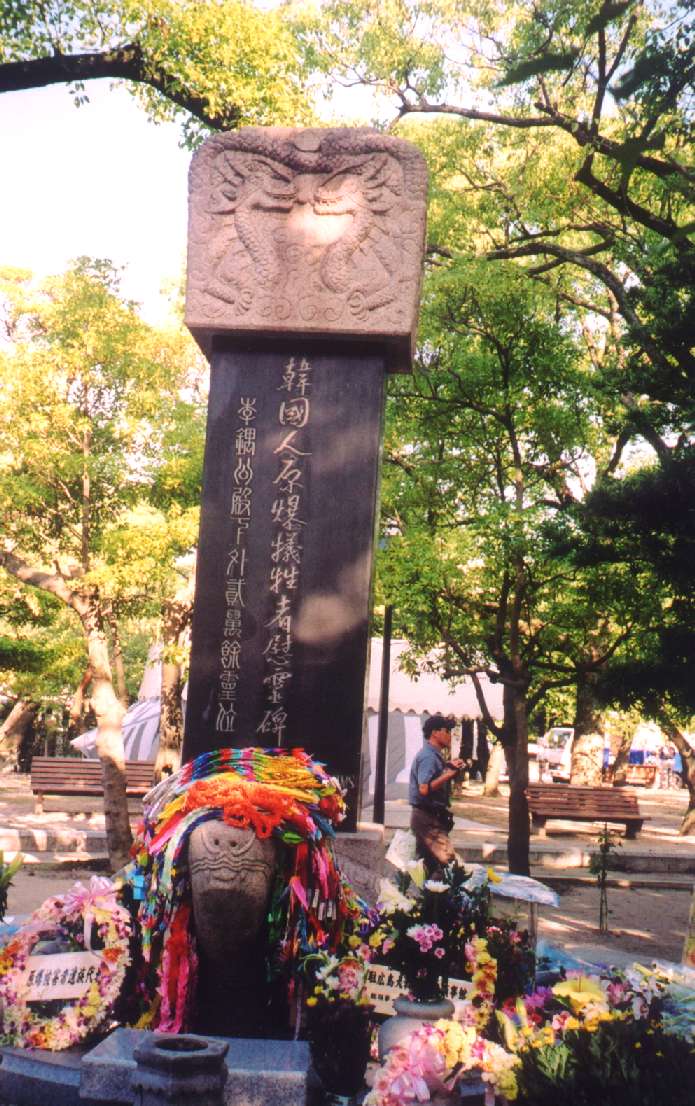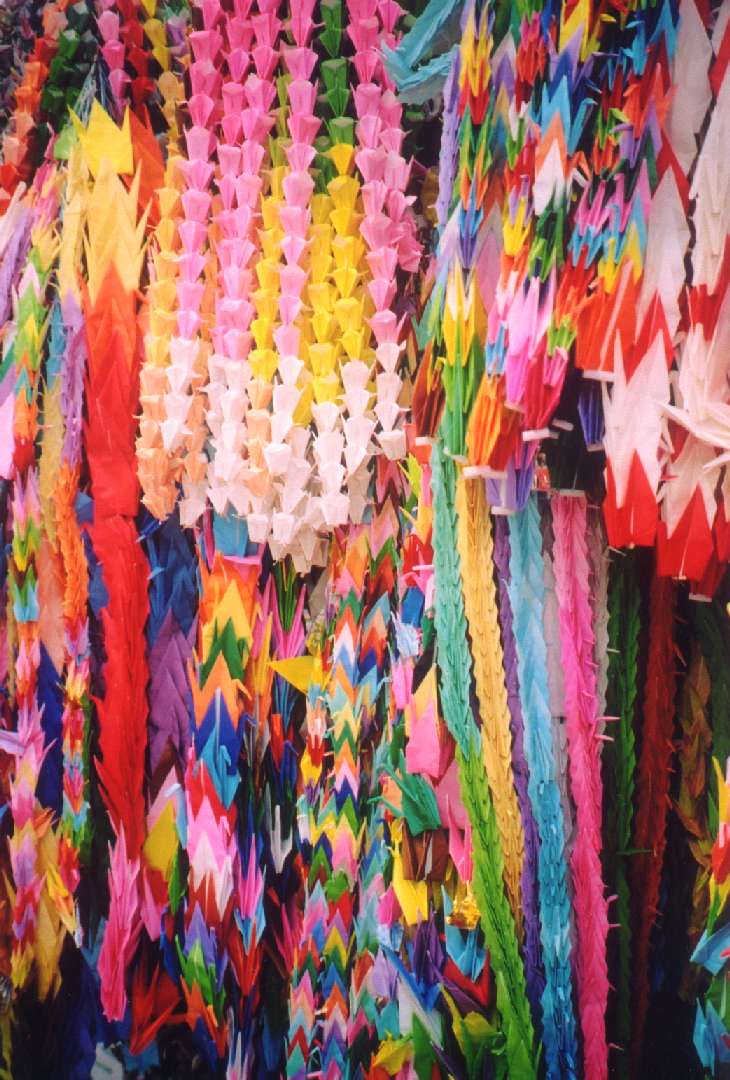Fifty-nine years after Hiroshima

Once
again, an August 6 has passed, with many people recalling the first use
in 1945 of an atomic weapon, against the unwarned, unsuspecting city of
Hiroshima; 3 days later, Nagasaki became the target of the second bomb.
In both cities, considerable numbers of Koreans were living, many of them
forcibly brought from their homes to work in support of the Japanese war
effort. Thousands of them were among the victims.
¡®It
was still quite early in the morning, when suddenly I had the impression
of something like a flash of lightning, then a fierce blast of wind came
blowing. It was terrifying; the upper floor of the building beside us went
flying through the air. Fortunately, we children were sitting in the shadow
of some trees and we escaped safely without being affected by burns. My
brother was attending class at the technical high school in central Hiroshima;
he had a narrow escape. He was working at a machine in the classroom when
he felt a blast of light; taking it for a flare, he went rushing outside
and at that very moment, he said, the school building collapsed. That brief
instant was all that separated life from death. We three survivors waited
for father, and went out looking for him too. We certainly thought that
he must have been killed, but it is very difficult to believe in a death
that one has not witnessed, and where no body can be found. Pregnant with
her third child, mother strove to find some trace of him, rummaging among
mounds of corpses, but to no avail. In the end we were obliged to leave
without being able to verify anything.¡¯
There
are hundreds of Koreans still alive who could tell similar tales, for there
were perhaps a million of them living in the southern regions of Japan,
including Hiroshima and Nagasaki, when the atomic bombs exploded on August
6 and 9, 1945. This particular account was written by Mok Sun-Ok, the widow
of the poet Chon Sang-Pyong. One of the many subjects of resentment between
Korea and Japan since then has been the deliberate exclusion by Japan from
treatment and benefits of the Korean victims, and especially those who,
like her family, chose to return to Korea. On the whole, only Japanese
nationals have been qualified
to receive financial and medical support. At the same time, many of those
afflicted by radiation sickness managed to return to Korea, but were unable
to find work due to their bomb-related disabilities. Some writers have
explained that in South Korea, where the mainstream interpretation of history
has been that the atomic bombings brought liberation and independence to
the motherland, it has been especially difficult for the A-bomb survivors
to gain sympathy from society. Moreover, no specialized doctors or hospitals
were available for A-bomb-related physical afflictions. Caught up in a
vicious cycle of no cure, no jobs and no money, these Korean A-bomb survivors
long remained in profound misery.
 The Korean Memorial
The Korean Memorial
In
April 1970, South Koreans living in Japan erected a memorial to the Korean
victims of the Hiroshima bomb. By that time, the Peace Park located at
the center of the city, just below the point where the bomb exploded, had
already become a place of international pilgrimage. Yet the Koreans did
not erect their momument within the park, and it was only in July 1999
that the Japanese authorities finally allowed it to be relocated there.
Previously, it had marked the spot where the body of a member of the Korean
royal family, killed by the bomb while serving as an officer in the Japanese
army, had been found. Every year, Koreans gather before the memorial on
August 5 to celebrate ritual offerings and ceremonies. Beside it is a stone,
in three languages, that indicates the ongoing issue in its closing words:
¡®we also pray that the plight of the Korean survivors, poorly understood
even today, will emerge into public awareness and that reasonable assistance
for these survivors will be provided immediately.¡¯ The main memorial is
itself deeply problematic, since its main inscription refers to kankokujin,a
term only used for citizens of the Republic of Korea. Since 2001 there
has been an agreement between the organizations in Japan related to North
and South Korea to replace it with a memorial dedicated to all Chosenjin,
Koreans in general. For very many Korean victims of the bombs returned
to North Korea and live or have died there.
When
I was walking in Peace Park on August 6 this year, it was striking that
almost no Koreans could be seen paying respects before the Korean memorial;
in part, no doubt, because of the previous day¡¯s ceremony, but perhaps
also a sign of their reluctance to be involved in ceremonies that seem
to stress too much the Japanese side of the tragedy. It is a familiar complaint
that the terrible sufferings of these two cities have been used by Japan
to divert attention from the atrocities committed by the Japanese through
the 20th century, even prior to the Pacific War, in Korea and
China. The finger of blame pointed at the United States for having bombed
Nagasaki without waiting to see if the declaration of war against Japan
by the USSR on August 8 would have any impact, the fact often stressed
in the museums in both cities that no prior warning was given to the innocent
citizens, and the implied suspicion that the bombs were used as much as
practical experiments as weapons of war, one being made of uranium the
other of plutonium, all sustain the argument that Japan was the innocent
victim of unjustified American violence. The account of the processes and
consultations by which the use of the bombs was approved in Washington
only reinforces the impression of mindless barbarity. The way the American
military tried after the war to prevent the publication of details on the
effect of the bomb on the people of the two cities does nothing to inspire
confidence; they even tried to hide the fact that the bombs had killed
a number of American prisoners-of-war.
 The Peace Bell
The Peace Bell
On
the other hand, there can be no doubt that the world as a whole remains
amazingly silent regarding the continuing existence of weapons of mass
destruction immensely more powerful than those used in 1945. In the 1960s,
the United Kingdom saw regular protests by members of the CND (Campaign
for Nuclear Disarmament) against the British nuclear deterrent and the
presence in Britain of American nuclear weapons. This campaign always remained
limited to a small minority, often considered to be naive or even pro-communist.
It is now virtually silent, yet Britain still possesses nuclear weapons,
although no decision of Parliament has ever sactioned that fact. Current
international discourse maintains the myth that it is fine for a small
number of western countries to have ¡®the bomb,¡¯ while Russia¡¯s bombs
are presented as a potential factor of risk, Israel¡¯s nuclear capacity
is ignored, India and Pakistan, it is implied, ought not to have the bombs
they almost certainly have, and no other country must be allowed to develop
them.
It
is only Hiroshima that has repeated for many years the constant message
that no country should be permitted to own even a single atomic bomb. To
prevent any repetition of the use of atomic bombs, the cities of Hiroshima
and Nagasaki have continually sought to remind the world of the inhuman
cruelty of nuclear weapons and have consistently urged the abolition of
such weapons. On 24 June 1982 at the 2nd UN Special Session on Disarmament,
Takeshi Araki, the then Mayor of Hiroshima, proposed a ¡®Programme to Promote
the Solidarity of Cities toward the Total Abolition of Nuclear Weapons¡¯.
This proposal offered cities a way to transcend national borders and work
together to press for the abolition of all nuclear weapons. Subsequently,
the Mayors of Hiroshima and Nagasaki called on mayors around the world
to support this programme. The ¡®Mayors for Peace¡¯ they launched is composed
of cities around the world that
have formally expressed support for the
programme announced by Mayor Araki in 1982. Each year, the Mayor of Hiroshima
at the ceremony held in the Peace Park in the morning of August 6 makes
a Peace Declaration. This year¡¯s Declaration included the words: ¡®The
city of Hiroshima, along with the Mayors for Peace and our 611 member cities
in 109 countries and regions, hereby declares the period beginning today
and lasting until August 9, 2005, to be a Year of Remembrance and Action
for a Nuclear-Free World. Our goal is to bring forth a beautiful ¡®flower¡¯
for the 75th anniversary of the atomic bombings, namely, the total elimination
of all nuclear weapons from the face of the earth by the year 2020. Only
then will we have truly resurrected hope for life.¡¯
In
contrast to the high idealism of this view, while North Korea claims the
right to develop nuclear weapons, no city in South Korea has ever associated
itself with the Mayors for Peace campaign. There are even indications that
many younger South Koreans feel proud of the prospect of North Korea becoming
a ¡®nuclear power¡¯ because they feel it will make the Korean people appear
more powerful, and will indicate their rejection of American hegemony.
They seem not to reflect on the potential use of such bombs; yet a nuclear
¡®deterrent¡¯ can only be credible if the nation owning it is prepared
to use it. Perhaps Korea too needs a CND campaign, but there are few signs
of one developing.
 Folded
paper cranes offered in Peace Park
Folded
paper cranes offered in Peace Park
See also the Hiroshima links